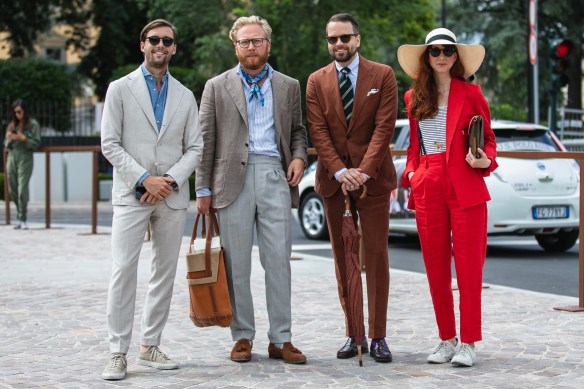“What Should I Wear To A Job Interview?” is one of the most common questions we get here at Styleforum, and the answer is always rather blunt: you should wear a suit and tie. This is absolutely never wrong for an interview once you have graduated from high school. It may be that your interviewer is not expecting you to be so “dressed up,” but nevertheless it is not a mistake for you to look your best. That means wearing a conservative but sharp outfit that adds to your appearance without competing with you for attention.

A Basic Uncontroversial Outfit (though many would leave out the pocket square)
![]()
- A single-breasted, two or three button, navy or dark gray/charcoal suit (i.e., jacket and pants made of the exact same fabric, not just same or similar color), tailored to fit you (especially make sure the sleeves are not down to your knuckles and the pants are not puddling around your ankles). If you don’t own a suit, read the Styleforum guide to buying your first suit.
- A white, spread collar, long-sleeved dress shirt with single cuffs (i.e. not French cuffs/double cuffs)
- A silk tie in a solid or simple pattern (pindots or stripes, for instance). Almost any color will do well with a white shirt and either of the aforementioned suits.
- Black cap-toe shoes and black belt (or suspenders/braces instead if your suit pants take them – but this is rare on ready-to-wear suits today). Check out this thread on Styleforum for more information on black formal shoes.
- Socks in the same color as the suit.
The above outfit is never wrong for a job interview. Nor is a job interview a time to get “creative” with your outfit, especially if you are not already well-versed in suit-and-tie-wearing, in which case you wouldn’t be reading this.
![]()
If you want to deviate from the above suggestions, you can wear a light blue shirt instead of a white one without much risk. In the United States, you can wear a button-down collar instead of a spread collar. Outside of England, in many industries, brown cap-toe shoes with a brown belt are acceptable substitutes for their black counterparts.
You can add a white pocket square in a “TV fold” without much risk, but if you’ve never worn such an item before, don’t make this the first time. It’s also fine to wear navy socks with a gray suit, gray socks with a navy suit, etc..
Avoid black socks or any kind of “fun” socks. Finally, an understated watch is acceptable jewelry, but do not wear a sports watch or a bulky and/or gaudy watch. Other than a wedding ring, this is the only kind of jewelry that is acceptable.
![]()
- A black suit (navy or grey only).
- An ill-fitting suit (get your suit tailored by someone experienced after purchasing). If you’re unsure about what could be tailored, read here first.
- A wrinkled shirt (iron your shirt before wearing).
- Shoes with square toes and/or rubber soles.
- Scuffed or dirty shoes (make sure your shoes are well-polished – if you don’t know how to do this or don’t have the proper equipment, visit a cobbler or read this guide).
- Bright colors or wild patterns (you do not want to be competing with your clothes for attention).
- Buttoning the bottom button on your jacket (it’s not meant to be buttoned – never do this).
- Removing your jacket (keep it on, with possible rare exceptions).
Here are a couple of examples of good outfits from Styleforum users. These men would be very well dressed for a job interview:
![]()
Somewhat riskier would be wearing French cuffs (double cuffs), as the cufflinks may be too flashy. Their appropriateness depends on your region and industry. Barrel cuffs (single cuffs) are always acceptable. More extravagant shoes such as wingtips fall into the same category. A suit in a subtle pinstripe or a striped shirt (with one color stripe on a white ground) can also work, but needlessly increase the difficulty of putting together a nice outfit. Any other kind of patterned suit should really not even be considered. Likewise, three-piece or double-breasted suits should be avoided.
Anything not mentioned to this point, such as wearing a sweater, a bowtie, a novelty tie, loafers, a cherry red dress shirt, etc. with your suit should be absolutely avoided. Remember, this is a job interview. You want to look professional, but with few exceptions, this is not a place to demonstrate your personal style.
![]()
If you are absolutely convinced that a suit and tie would be inappropriate, for instance, if you are told specifically not to wear a suit and tie, lose the tie before you lose the jacket. Wearing a tie without a jacket makes you look like a cell phone salesman at the mall. A professional might wear a sportcoat and trousers with no tie, but never a tie without a jacket. You will have more latitude in these less formal situations, but the same principles of keeping your clothing clean, simple, and well-fitting still apply.
![]()
Whatever you wear, wear it confidently. If you arrive in a suit and your interviewer says something like, “you didn’t need to dress up for us!” don’t look sheepish, just smile and say, “I wanted to look my best.” Finally, and I hope obviously, but perhaps most importantly, nothing is less stylish than poor personal hygiene. Get a decent haircut, take a shower, and clip your fingernails!
If you’re still not sure about what to wear, visit the Styleforum Style Advice forum and ask for help here.
This is an edited version of an article published on Styleforum in 2012 by Styleforum member Shawea.






































































